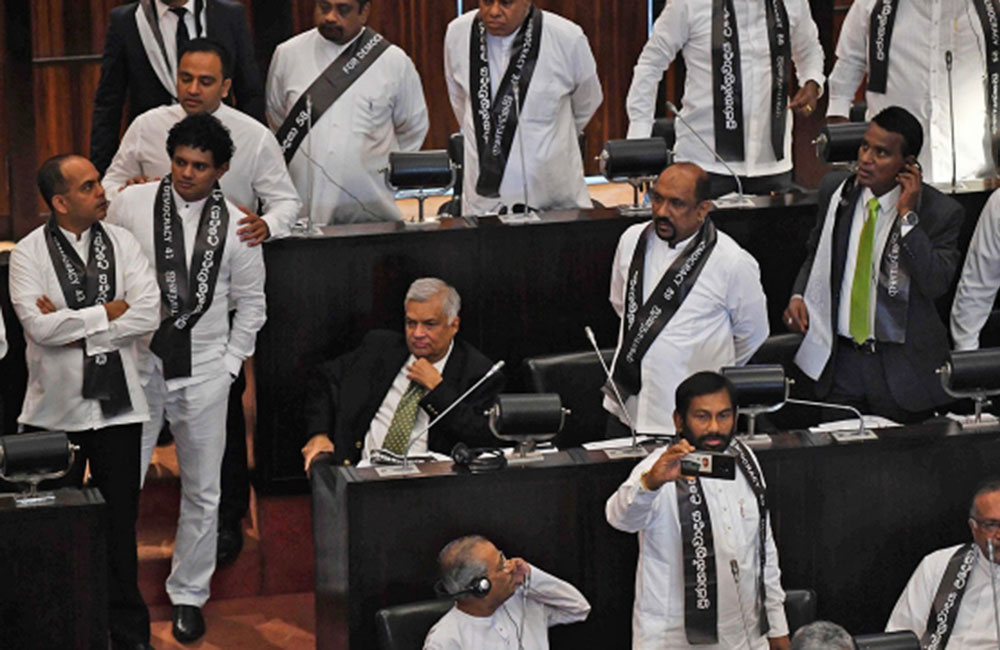The schemes of Maithripala Sirisena, the president of Sri Lanka, are blowing up in his face. On November 13th the Supreme Court suspended his order dissolving parliament and calling a snap general election. The next day the reinstated parliament raucously approved a motion of no confidence against the government that the president had only just installed. It was a stinging rebuke to Mr Sirisena, who had stretched the constitution in his attempt to replace a supposed ally, Ranil Wickremesinghe (pictured, sitting), with a supposed enemy, Mahinda Rajapaksa.
The president has put Sri Lanka in a constitutional quandary. It now has no clear government. Mr Rajapaksa’s team have occupied all the ministries, but Mr Wickremesinghe’s insists that it remains the legitimate cabinet. “We went from one prime minister to two prime ministers to no prime minister in a span of 20 days,” says Thishya Weragoda, a bemused lawyer.
The crisis began on October 26th, when Mr Sirisena abruptly sacked Mr Wickremesinghe’s government—a power the constitution reserves for parliament, under an amendment Mr Sirisena himself ushered into law. The president denounced Mr Wickremesinghe as arrogant and stubborn. He replaced him with Mr Rajapaksa, a populist former president in whose cabinet Mr Sirisena had served from 2005 to 2014, before allying with Mr Wickremesinghe to defeat Mr Rajapaksa in the presidential election the following year. Mr Sirisena later accused Mr Rajapaksa of corruption and even of plotting to kill him.
Mr Sirisena now insists that Mr Rajapaksa is the best candidate for prime minister. To avoid learning parliament’s view, he suspended it for three weeks. Meanwhile, he swore in a new cabinet. But Mr Wickremesinghe refused to give way, calling his sacking illegal. The bureaucracy fell into near paralysis.
In response to growing pressure, Mr Sirisena grudgingly called for the legislature to convene on November 14th. He gambled on gaining the required 113 votes in the 225-seat parliament to validate Mr Rajapaksa’s appointment. MPs claim they were offered cabinet portfolios and millions of dollars to support the new order. Even so the numbers looked to be falling well short. So on November 9th Mr Sirisena dissolved parliament altogether and announced a snap election—again, a move that appeared to exceed his constitutional authority.
Mr Wickremesinghe’s backers complained to the Supreme Court. After two days of hearings, the three-judge bench—including the chief justice recently appointed by Mr Sirisena—suspended the presidential decree dissolving parliament. The ruling applies until December 7th, when the court will take up the case again.
That led to chaotic scenes in parliament. Mr Sirisena did not turn up to deliver the president’s customary statement at a re-opening. Mr Rajapaksa took the seat allotted to the prime minister. His supporters disrupted attempts to vote on the no-confidence motion with a show of hands, so 122 MPs signed a letter saying they had voted for it. The speaker notified Mr Sirisena, who declared the vote irrelevant.
Mr Rajapaksa’s supporters are defiant. Dinesh Gunawardena, an MP, tweeted that they would not accept the decision as “there was no vote taken”. They argue the speaker is biased. But in a triumphant press conference, Mr Wickremesinghe warned police and public officials not to follow “illegal orders from the purported government that has failed to demonstrate the confidence of the people”. He invited Mr Rajapaksa to propose a fresh vote if he had difficulty accepting the legitimacy of the one that had already taken place. Mr Wickremesinghe said his administration will take steps to ensure the government in place before October 26th will continue. How he will do that remains to be seen.
Mr Sirisena, angry and defiant, retains nominal control of the army and police while Mr Rajapaksa, sullen and chagrined, enjoys widespread public support. That is the crowning irony: had he simply waited for elections in two years’ time, he would probably have walked into the job.
This article appeared in the Asia section of the print edition of Economist under the headline "Putsch-tush"

Leave your comments
Login to post a comment
Post comment as a guest